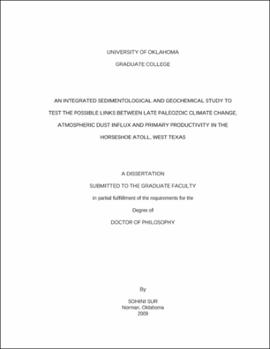| dc.contributor.advisor | Soreghan, Gerilyn S | |
| dc.creator | Sur, Sohini | |
| dc.date.accessioned | 2019-04-27T21:23:23Z | |
| dc.date.available | 2019-04-27T21:23:23Z | |
| dc.date.issued | 2009 | |
| dc.identifier | 99142658202042 | |
| dc.identifier.uri | https://hdl.handle.net/11244/318565 | |
| dc.description.abstract | Atmospheric dust is an important climatic agent as well as a valuable climatic archive. Recent studies have hypothesized ample dust deposits (loess) from late Paleozoic western equatorial Pangaea. However their relation with late Paleozoic climate change is understudied. In this study, I developed a methodology for sequential extraction of the silicate mineral fraction (SMF, a proxy for dust influx) from lithified carbonates and have applied this method to paleoclimatic interpretation of an upper Pennsylvanian glacio- eustatic sequence of Horseshoe Atoll, an isolated carbonate buildup of the Midland basin (west Texas). | |
| dc.description.abstract | The studied cycle (~ 30 m thick) consists almost entirely of carbonate with a thin interval of dark, pyritic mudrock at the sequence boundary. The SMF contains both detrital and authigenic silica and, using paleogeography, stratigraphy and petrographic constrains, both components are inferred to be of eolian origin. Accordingly, the SMF can be used as a proxy for atmospheric dust and attendant aridity. Dust varies over 2 orders of magnitude within the carbonate succession and is over 3 orders of magnitude higher in the mudrock. The mudrock is interpreted as a loess deposit that was pedogenically modified and subsequently transgressed. The stratigraphic position of the the mudrock, juxtaposed between the sequence boundary and early transgressive carbonate facies, suggests maximum aridity during lowstand to early transgression (glacial to incipient interglacial). Spectral analyses of the dust fraction within the carbonate reveals Milankovitch scale (< 105yr) variations in atmospheric conditions through a single glacial cycle. Remarkably high abundance of highly reactive iron within the mudrock together with recent recognition of high atmospheric dust load during the late Paleozoic suggest high reactive iron input to the late Paleozoic ocean and attendant marine primary productivity. | |
| dc.format.extent | 137 pages | |
| dc.format.medium | application.pdf | |
| dc.language | en_US | |
| dc.relation.requires | Adobe Acrobat Reader | |
| dc.subject | Climatic changes | |
| dc.subject | Dust--Environmental aspects | |
| dc.subject | Paleoclimatology | |
| dc.subject | Sediments (Geology)--Texas | |
| dc.title | An integrated sedimentological and geochemical study to test the possible links between late Paleozoic climate change, atmospheric dust influx and primary productivity in the Horseshoe Atoll, west Texas | |
| dc.type | text | |
| dc.type | document | |
| dc.thesis.degree | Ph.D. | |
| ou.group | Mewbourne College of Earth and Energy::ConocoPhillips School of Geology and Geophysics | |
